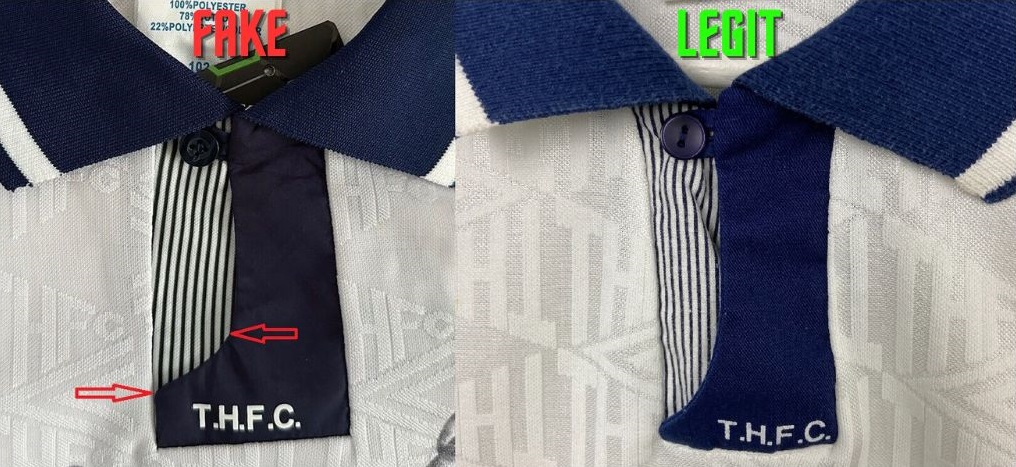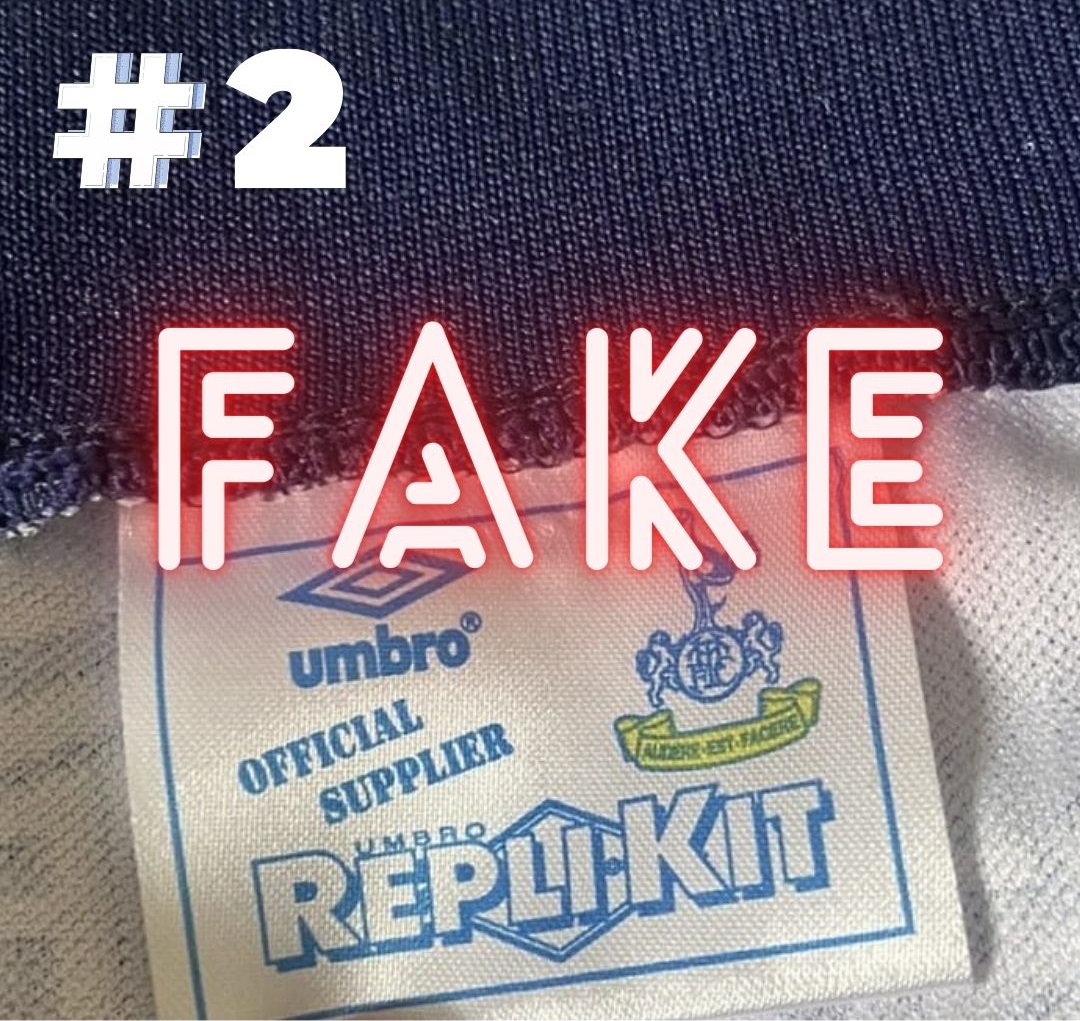Retro Fake #2 – Umbro Repli-Kit shirts
History and guide – how to spot a fake Umbro Repli-Kit shirt?
In the second episode of the "Retro Fake" series, we will take a look at Umbro's "Repli-Kit" series, which took place in 1989–1993. However, before I discuss and analyze individual jerseys, let's get acquainted with the short history of that period in Umbro's activities.
What is “Repli-Kit” from Umbro?
At the turn of the 1980s and 1990s, the market for replica football shirts experienced a real boom. Umbro, which was one of the pioneers in selling replicas, used a little marketing gimmick in 1989 when it introduced the "Repli-Kit". The entire campaign was aimed at popularizing the purchase of football shirts by fans, and Umbro advertised it with a catchy slogan: „Make sure you’re wearing the winning kit – REPLI-KIT”.

Catalogs appear, containing a large selection of football uniforms for clubs and national teams, dressed at that time by Umbro. In addition to replica shirts, fans also had the opportunity to order training equipment, such as entire tracksuit sets or T-shirts of their favorite teams. In turn, Repli-Kit boxes were available for sale for the youngest children, i.e., boxes containing a shirt, shorts and socks. The predecessor of this type of set was "Umbroset for Boys".


Interestingly, despite the huge revolution carried out by Umbro, initially the largest possible shirt size available to fans was 42" (107 cm), i.e., the equivalent of size Large (photo of the catalog from 1989). Larger sizes began to appear on the market in the following seasons.

Sponsor logos on„Repli-Kit” shirts
You've probably wondered why Umbro shirts from that period didn't always have sponsors. Sponsor logos on replicas were not as obvious as they are now. Most of the club's "Repli-Kit" shirts were available for purchase without the sponsor's logo. It was often the case that sponsor logos were sold separately in official stores, and fans could apply them to their own shirts. I think this will be quite well illustrated by the following Umbro advertisement for Manchester City from 1989, where there is no "Brother" logo on the jerseys.

Types of Umbro Repli-Kit Tags
Umbro "Repli-Kit" shirts are associated primarily with a characteristic label with a large "Repli-Kit" logo and the club's crest. For this reason, less experienced people often wrongly consider shirts from this series as modern reproductions. The name "Repli-Kit" certainly doesn't help, and if someone sees a jersey from this series for the first time, they may be too quick to conclude that it cannot be a piece from 30 years ago.

However, the above-mentioned flagship "Umbro Repli-Kit" label was not placed on shirts from this series from the very beginning, and only appeared in 1991. For this reason, many shirts from that period that were used for more than one season have different labeling.

At this point, it is worth noting the change that Umbro initiated at the start of the 1992–93 season. It was the inaugural season of the Premier League, and the English company was the technical sponsor of as many as 11 of the 22 clubs in the league. Umbro decided to introduce a new design, and the clubs' premiere shirts from this season had different labels because they came from a new collection. Nine clubs received one new kit each, and Manchester United, due to the fact that it was just starting cooperation with Umbro, received completely new kits: home, away and third (for this reason, there are no Repli-Kit tags on United's shirts from 1992–1993 season). The exception was Tottenham Hotspur, who decided to keep all their previous kit versions. For example, this is what the labels on the Ipswich Town home and away shirts looked like in the 1992/93 season:

How to spot a fake Umbo "Repli-Kit" shirt (examples)?
After getting acquainted with the history and a few interesting facts, let's move on to the most important thing, i.e. examples in which I will try to show what you need to pay attention to in order not to fall for a fake.
1. Tottenham Hotspur 1991-93 home
- Tags

As we can see, the differences between the non-original Tottenham shirt with the Repli-Kit flagship label and the original with the same type of label are huge. The light blue colors and the terrible quality of the club crest are absolute red flags. Usually, under this tag, you will also find a tiny tag with the size, which should completely dispel your doubts and confirm that you are dealing with a fake.

Attention! It happens that these small size tags are cut out by sellers who are aware that they have a fake shirt. It is worth checking whether there is any trace of it under the main label.
However, the most common tag that we will encounter in a fake Tottenham 91-93 home shirt is this:

- Button fastening
Another very characteristic element of this shirt is the button fastening under the neck. Manufacturers of fakes clearly cannot reproduce the original at this point. Our attention should be drawn to the button, which will differ in shade, number of holes (four in the fake version), and even shape.
It is also worth taking a look at the white and navy blue striped pattern, as well as the shape and place of sewing of the uniform navy blue part. The whole thing is topped with a worse-made inscription (T.H.F.C).

The above comparison shows very nicely how the collar clearly differs in the quality of the material.
- Umbro logo
One last helpful detail to verify the legitimacy of this shirt is the Umbro logo. In the original, it is more convex and differs in the material from which it is made.

2. Wales 1990-91 home
National team shirts are more difficult to verify due to the fact that they have fewer details that we can compare. A good example from the Umbro Repli-Kit series is the Wales home shirt from 1990/91.
- Crest
At first glance, when we don't have the original to compare, the Welsh Football Association's crest looks quite decent, and you can be fooled by it. Then it is worth checking a few details, which should explain a lot and guide us to what type of shirt we are dealing with. These details include:
- color of the shield - basically, the crest on all fakes is dark green.
- the eye of the Welsh dragon - it's practically impossible to find it on the fake kit.
- motto "Gorau chwarae cyd chwarae" (Eng: "Best play, play together") - more legible and expressive in the original.
- dragon scales - in the fake version they look more like a shell than scales like in the original.

- Material under the fastening
Fake producers, no matter how hard they try to deceive us, will always leave some very obvious error that ruins their efforts. In the case of this shirt, an eye-catching defect is a different color under the fastening at the neck. In fakes it is white and should be red.

- Decorative stripes on the sleeves
Umbro diamond patterns on the decorative stripes on the sleeve can also tell us that there is something wrong with the shirt.

3. Celtic 1991-92 away
- Material quality and sponsor
Using the example of the Celtic 91/92 away shirt, we can clearly see how much the fake material differs from the original. Regardless of the colors, which look different at first glance, our attention should be drawn to a material with a completely different structure. In general, the entire pattern of the shirt looks very poor.
A bright sponsor's logo made of rubber material should also light up the red light. In the comparison below, we can also see a defect at the connection of the letters "E" and "S".

- Pattern on the collar
The last very useful detail that I would like to show you about the "Repli-Kit" is the pattern on the collar, which can be found not only in this particular Celtic shirt but also in many others from this collection.
As we can see, traditionally, the fake shirt does not come here with its colors, and the decorative pattern itself is simply poorly made.

Finally, I would like to thank everyone who made it to the end of the text. I hope it will be helpful for you. Another article from the "Retro Fake" series is coming soon!
Christmas is ahead of us, so I would like to wish you all a Merry Christmas and, of course, lots of football shirts under the Christmas tree :)






